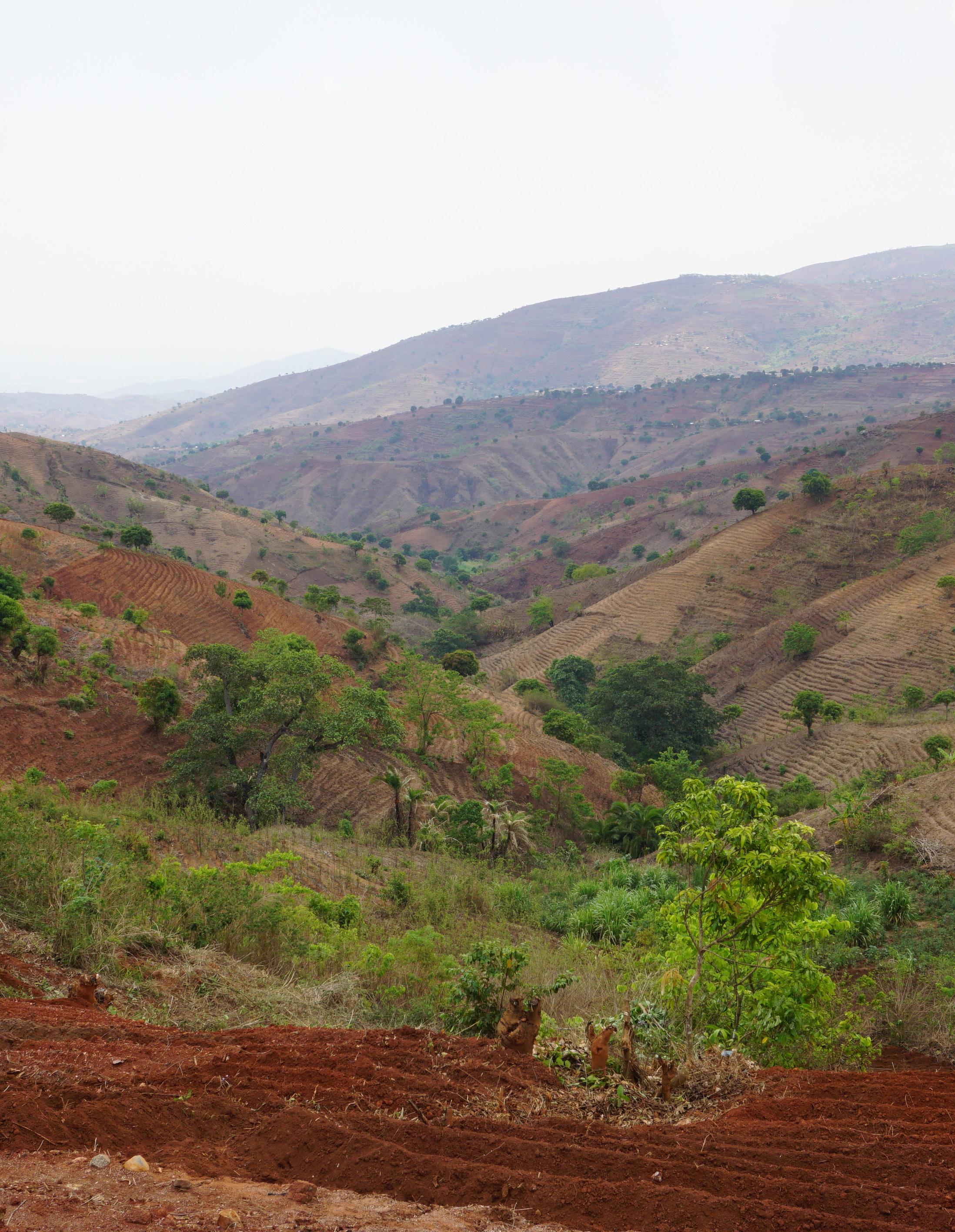
3 minute read
Reflection of Final Review
The intent of this program proposal and design was meant to spark interest in the idea of GM crops and biopharming. It is a very bold and modern approach to solving the issues of food insecurity and lack of vaccines, but it could be something accepted within the culture if given enough willingness. The integration of a vernacular site and materiality was successful in that it created an incredible relationship with the landscape, which is common in Malawi. The use of vernacular elements was meant to offset the modernity of the program. However, the program might need more elements like this that are less intrusive to the cultural norms and are more supportive of the economy and education of the people. This could include things like providing jobs for people to construct these buildings on site, offering community education on these agricultural biotech methods and products, or viewing this as an economic opportunity to export the produce and vaccines to provide revenue for the country.
Further developments could be made in regard to the internal service circulation between buildings, the circulation routes and typologies being shaded or unshaded, solar strategies, and the amount of solar power necessary to mechanically ventilate the labs.
Advertisement
Overall, this program proposal and design will provide the KUHeS campus with an opportunity to mitigate food and drug insecurity, create more nutritional food, increase crop yield, produce and export their first vaccines, and educate the community about the value in biotech agriculture.
Endnotes
1. “Malawi IPC Chronic Food Insecurity Report - May 2022 in Malawi,” United Nations, accessed May 13, 2023, https://malawi.un.org/en/182748-malawi-ipc-chronic-food-insecurity-reportmay-2022, 7.
2. Ibid.
3. “Malawi IPC Chronic Food Insecurity Report - May 2022 in Malawi,” United Nations, accessed May 13, 2023, https://malawi.un.org/en/182748-malawi-ipc-chronic-food-insecurityreport-may-2022, 10.
4. “Malawi National Multi-Sector Nutrition Policy 2018-2022,” National Multi-Sector Nutrition Policy 2018–2022, accessed May 14, 2023, https://extranet.who.int/nutrition/gina/sites/default/ filesstore/MWI_2018_National-Multi-Sector-Nutrition-Policy.pdf, 4.
5. “Seeding Labs’ Instrumental Access 2016: Luanar,” Seeding Labs, September 12, 2018, https://seedinglabs.org/programs-and-impact/instrumental-access-old/instrumental-access-2016/ lilongwe-university/.
6. “Health Sector Strategic Plan II - Who/OMS Extranet Systems,” Health Sector Strategic Plan II (2017-2022), accessed May 14, 2023, https://extranet.who.int/countryplanningcycles/sites/ default/files/planning_cycle_repository/malawi/health_sector_strategic_plan_ii_030417_smt_dps.pdf.
7. “Malawi,” Clinton Health Access Initiative - Malawi, April 26, 2023, https://www. clintonhealthaccess.org/malawi/.
8. Olalekan Akinbo et al., “Commercial Release of Genetically Modified Crops in Africa: Interface between Biosafety Regulatory Systems and Varietal Release Systems,” Frontiers in Plant Science 12 (2021), https://doi.org/10.3389/fpls.2021.605937.
9. Ibid. 10. “MW2063 Vision: United Nations Development Programme,” UNDP, accessed May 13, 2023, https://www.undp.org/malawi/publications/mw2063-vision.
11. Ibid.
12. Norman Muzhinji and Victor Ntuli, “Genetically Modified Organisms and Food Security in Southern Africa: Conundrum and Discourse,” GM Crops & Food 12, no. 1 (2020): 25–35, https://doi.org/10.1080/21645698.2020.1794489.
13. “Technology | Cape Biologix Technologies,” Cape Biologix, accessed May 14, 2023, https:// capebiologix.com/technology/.
14. Center for Food Safety and Applied Nutrition, “Science and History of Gmos and Other Food Modification Processes,” U.S. Food and Drug Administration, accessed May 13, 2023, https://www. fda.gov/food/agricultural-biotechnology/science-and-history-gmos-and-other-food-modificationprocesses.
15. Kingdom Kwapata, “Lilongwe University of Agriculture and Natural Resources (Luanar) Bunda ...,” APPLICATION FOR CONFINED FIELD TRIAL (CFT) OF BtCOWPEA, accessed May 14, 2023, https://afsafrica.org/wp-content/uploads/2015/02/Bt-COW-PEA-CFT-Application-NBRC-2015.pdf.
16. “Home: Cape Bio Pharms,” Cape Bio Pharms, accessed May 13, 2023, https://www. capebiopharms.com/.
17. Ron Eglash, African Fractals: Modern Computing and Indigenous Design (New Brunswick, NJ: Rutgers University Press, 2005), https://monoskop.org/images/f/fc/Eglash_Ron_African_ Fractals_Modern_Computing_and_Indigenous_Design.pdf.
Bibliography
Akinbo, Olalekan, Silas Obukosia, Jeremy Ouedraogo, Woldeyesus Sinebo, Moussa Savadogo, Samuel Timpo, Ruth Mbabazi, Karim Maredia, Diran Makinde, and Aggrey Ambali. “Commercial Release of Genetically Modified Crops in Africa: Interface between Biosafety Regulatory Systems and Varietal Release Systems.” Frontiers in Plant Science 12 (2021). https://doi. org/10.3389/fpls.2021.605937.
Center for Food Safety and Applied Nutrition. “Science and History of Gmos and Other Food Modification Processes.” U.S. Food and Drug Administration. Accessed May 13, 2023. https:// www.fda.gov/food/agricultural-biotechnology/science-and-history-gmos-and-other-foodmodification-processes.
Eglash, Ron. African fractals: Modern Computing and indigenous design. New Brunswick, NJ: Rutgers University Press, 2005. https://monoskop.org/images/f/fc/Eglash_Ron_African_Fractals_ Modern_Computing_and_Indigenous_Design.pdf.
“Health Sector Strategic Plan II - Who/OMS Extranet Systems.” Health Sector Strategic Plan II (20172022). Accessed May 14, 2023. https://extranet.who.int/countryplanningcycles/sites/default/ files/planning_cycle_repository/malawi/health_sector_strategic_plan_ii_030417_smt_dps.pdf.
“Home: Cape Bio Pharms.” Cape Bio Pharms. Accessed May 13, 2023. https://www.capebiopharms. com/.
Kwapata, Kingdom. “Lilongwe University of Agriculture and Natural Resources (Luanar) Bunda ...” APPLICATION FOR CONFINED FIELD TRIAL (CFT) OF BtCOWPEA. Accessed May 14, 2023. https://afsafrica.org/wp-content/uploads/2015/02/Bt-COW-PEA-CFT-Application-NBRC-2015. pdf.
“Malawi IPC Chronic Food Insecurity Report - May 2022 in Malawi.” United Nations. Accessed May 13, 2023. https://malawi.un.org/en/182748-malawi-ipc-chronic-food-insecurity-report-may-2022.
“Malawi National Multi-Sector Nutrition Policy 2018-2022.” National Multi-Sector Nutrition Policy 2018–2022. Accessed May 14, 2023. https://extranet.who.int/nutrition/gina/sites/default/ filesstore/MWI_2018_National-Multi-Sector-Nutrition-Policy.pdf.
“Malawi.” Clinton Health Access Initiative - Malawi, April 26, 2023. https://www.clintonhealthaccess. org/malawi/.
Muzhinji, Norman, and Victor Ntuli. “Genetically Modified Organisms and Food Security in Southern Africa: Conundrum and Discourse.” GM Crops & Food 12, no. 1 (2020): 25–35. https://doi.or g/10.1080/21645698.2020.1794489.
“MW2063 Vision: United Nations Development Programme.” UNDP. Accessed May 13, 2023. https:// www.undp.org/malawi/publications/mw2063-vision.
“Seeding Labs’ Instrumental Access 2016: Luanar.” Seeding Labs, September 12, 2018. https:// seedinglabs.org/programs-and-impact/instrumental-access-old/instrumental-access-2016/ lilongwe-university/.
“Technology | Cape Biologix Technologies.” Cape Biologix. Accessed May 14, 2023. https:// capebiologix.com/technology/.




